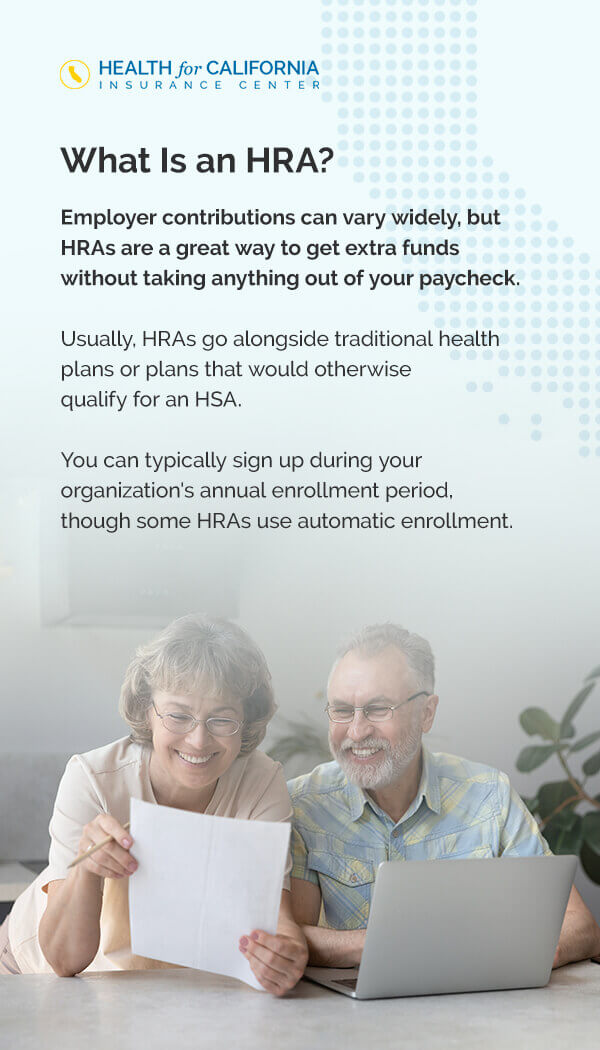What’s the Difference Between HSA, FSA and HRA?
Posted: March 15, 2023

Even with insurance, many people find themselves with a wide range of health-related costs, like paying for over-the-counter medications, disease management supplies and dental implants. To help offset these costs, many employers offer health accounts or arrangements, including health savings accounts (HSAs), flexible spending accounts or arrangements (FSAs) and health reimbursement accounts or arrangements (HRAs).
Each type of account works a little differently and may affect how much money you and your employer can contribute, how you can spend the money and who owns it if you leave your job. Let’s dive into the nitty gritty and discuss the pros and cons of HRA, FSA and HSA programs.
Tax-Advantaged Health Accounts
All of these accounts — HRAs, FSAs and HSAs — are tax-advantaged, meaning the contributions, or the funds you put into the account, are untaxed. You can put the funds toward eligible expenses for medical, vision and dental care. Some plans allow employers to choose what expenses are covered, but they must come from the list provided by the Internal Revenue Service (IRS).
Some common HRA-, HSA- and FSA-eligible expenses include:
- Copays and coinsurance
- Medical equipment, like crutches, hearing aids or wheelchairs
- Prescription medications
- Over-the-counter medications like pain relievers and decongestants, but not vitamins or supplements unless recommended by a health professional
- Supplies, such as incontinence pads, diabetic testing equipment and sleep apnea pumps
- Family planning expenses like fertility tests, birth control and condoms
- Dental care, including braces, cleanings, exams and dentures
- Vision care, including contact lenses, eyeglasses and exams
- Acupuncture and chiropractic services
- Physical therapy
- Therapy or counseling, smoking cessation programs and drug or alcohol dependency treatment
- Vaccinations
Some accounts can cover certain health insurance premiums like those for Medicare, the Consolidated Omnibus Budget Reconciliation Act (COBRA) and long-term care insurance.
Before we dive into different types of tax-advantaged accounts, let’s define a few terms:
- Contribution: Depending on the plan, a contribution can come from you, your employer or your family members. You might pay a contribution directly from your paycheck, or an employer could contribute once a year.
- Distribution: A distribution occurs when you use the funds, either directly on medical expenses or indirectly through a larger withdrawal.
- Use it or lose it: If you hear funds referred to as “use it or lose it,” they expire at a specific time, usually the end of the year.
- Tax-free: Tax-free contributions and distributions aren’t assessed any additional taxes, such as state income tax or Federal Insurance Contributions Act (FICA) tax. FICA refers to Social Security and Medicare taxes.
- Tax-deductible: If a contribution is tax-deductible, you can deduct the value of your contributions from your taxes at the end of the year.

What Is an HSA?
A health savings account is a tax-free savings account that you own that’s attached to a high-deductible health plan (HDHP). If you purchase an individual health plan — i.e., not one offered by your employer — an HSA is the only kind of tax-advantaged account you can get, but employer-owned health plans can also offer HSAs. You and your family members can contribute, and if your employer provides your health plan, they can contribute to the account, too.
HSAs are the most flexible of these three options because the account fully belongs to you, not your employer. That means that if you leave your employer, the money is still yours. Those funds don’t expire, even if you switch health plans or leave your job. You won’t need to worry about use-it-or-lose-it funds going away at the year’s end. An HSA covers medical expenses under the IRS list except for most health insurance premiums.
You can adjust your contribution at any time and enjoy tax benefits up to a specified amount. The 2023 limits are $3,850 for individuals and $7,750 for families. If you’re over 55 years old, you can contribute an additional $1,000. You can typically enroll in an HSA-qualified plan during your employer’s annual enrollment period. For a plan you bought on your own, you can sign up for an HSA at any time.
How HSAs Are Taxed
You’ll need to report an HSA account on your taxes, but your contributions are tax-deductible and tax-free under federal and FICA taxes. Most states don’t charge income tax, but some, like California, do impose state income taxes on HSAs. Many plans accrue interest on your contributions to help you grow their value tax-free. You can also invest the money from your account tax-free.
Although you can withdraw your funds for any reason, using them for unqualified medical expenses will subject them to income tax and a 20% penalty. However, the penalty doesn’t apply if you’re over 65 or disabled. Otherwise, qualified distributions are generally tax-free.

What Is an FSA?
A flexible spending account is a little different. Your employer owns the account, which is usually attached to a traditional health plan — not necessarily an HDHP — that your employer offers. While you and your employer can both contribute to an FSA, you don’t get to keep the funds if you don’t use them. At the end of the plan year, for example, any unused funds go back to your employer. You also can’t invest these funds, and interest does not accrue.
You can use your FSA funds on qualifying medical, dental or vision expenses from the IRS list, except for health insurance premiums. You can use FSA funds for you and your family members.
The employee’s contribution limit for an FSA is $3,050 for 2023, and employer contributions are usually limited to $500. You can typically adjust your contribution amount or sign up for an FSA during your employer’s annual enrollment period or during a qualifying life event.
Some employers allow you to carry over unused funds into the following year. You may be allowed to roll over up to $610 or take up to 2.5 months to use your remaining balance. If you leave the company, you’ll forfeit any funds left over unless you’re eligible for and opt to continue coverage under COBRA.
Keep an eye out when reviewing your benefits because your employer may offer a few types of FSAs. We’ve been talking about health FSAs, but you might also come across:
- Dependent care FSAs: These accounts cover care services for your dependents, like day care.
- Limited-purpose FSAs: A limited-purpose FSA is typically used alongside an HSA and a high-deductible plan. The FSA would only cover eligible vision and dental expenses.
How FSAs Are Taxed
Like an HSA, FSA contributions are exempt from federal and FICA taxes. They’re exempt in all states, too, including California. Reimbursements are also tax-free. Unlike an HSA, you cannot deduct FSA contributions, and you don’t need to report them on your taxes. You also can’t deduct medical expenses paid with FSA funds from your taxes.

What Is an HRA?
A health reimbursement account is another kind of employer-owned account. It doesn’t require an HDHP and is mostly controlled by your employer, who also funds the account. The employer can determine what expenses from the IRS’s list are eligible, including health and long-term care insurance premiums. Employer contributions can vary widely, but HRAs are a great way to get extra funds without taking anything out of your paycheck.
Usually, HRAs go alongside traditional health plans or plans that would otherwise qualify for an HSA. You can typically sign up during your organization’s annual enrollment period, though some HRAs use automatic enrollment. Like an FSA, any unused funds will expire, but some HRA plans will allow you to roll them over. If you leave the company, you won’t be able to carry funds with you to another employer.
Since the employer is the one contributing, there are no contributions you would be able to invest, save or accrue interest on. You also can’t withdraw funds for anything besides eligible healthcare expenses.
You might come across a few different types of HRAs, but the difference mostly comes down to how your employer’s company is organized:
- Original HRAs: You may have an original HRA if you’re enrolled in a traditional group plan like a preferred provider organization (PPO), health maintenance organization (HMO) or HDHP.
- Qualified small employer HRAs (QSEHRAs) or individual coverage HRAs (ICHRAs): If you don’t have a group plan and instead need to buy an individual plan, your employer may offer one of these HRAs. A QSEHRA applies to the whole company, while an ICHRA applies to certain worker classes.
How HRAs Are Taxed
All contributions come from the employer, so an HRA member doesn’t need to report the account on their taxes or worry about how earnings are taxed. All reimbursements are tax-free.
HSA vs. FSA vs. HRA
You’ve probably noticed how the many differences between HSA, FSA and HRA options can significantly affect your healthcare budget. These tax-free accounts share some similarities and a lot of easy-to-miss differences.
Some of the things you’ll get with virtually any of these accounts include:
- Tax-free funds: While the tax details can vary, you’ll generally get funds to use that are free of state and federal taxes.
- Easy spending: Most programs allow you to spend your funds with easy-to-use payment methods, like debit cards, payments to medical providers or direct deposit reimbursements.
- Similar eligible expenses: Although employers have more say in an HRA, most of these accounts cover similar expenses, thanks to documentation from the IRS.
The list of differences between HSAs, FSAs and HRAs is much longer. Here are some of the ways these accounts vary:
- Plan compatibility: HRAs and FSAs work alongside any kind of plan, but if you want an HSA, you’ll need a health insurance plan with a high deductible. HSAs can combine with dependent care FSAs and limited-purpose FSAs to cover other costs. HRAs are compatible with health FSAs, too.
- Timing of reimbursement: Generally speaking, you can only pay for FSA expenses if you incurred them during your plan year. HSAs can reimburse at any time, and you can even save receipts for later reimbursement after you’ve contributed more. HRAs often only reimburse you for expenses incurred after you established the account.
- Availability of funds: An HSA works more like a savings account, so you can only access the funds you’ve already put into it. An FSA, on the other hand, lets you access the total amount for the plan year from day one. HRAs might have funds available immediately or prorate them throughout the year.
- Expense verification: FSAs and HRAs may need you to prove that your expenses are qualified before they reimburse you. An HSA doesn’t require verification, but you would need to prove the eligibility of your expenses if audited by the IRS.
- COBRA premiums and rights: You can use an HSA or HRA for COBRA premiums, but not an FSA. COBRA rights refer to the ability to keep your employer-provided health benefits after a job loss. They apply to FSAs and HRAs, but not HSAs.
- Contribution limits: HSAs and FSAs have contribution limits set by the IRS, but HRAs do not.
- Roll-over funds: HSA funds always roll over. FSA and HRA funds might allow you to roll some portion of your funds over.
- Contributors: You can contribute to an HSA or FSA, and only your employer contributes to an HRA. Other people, like family members, can also contribute to an HSA.
- Investment options: HSAs are the only accounts that offer investment options.
This list is not exhaustive. Every plan is different, so work with an insurance expert if you’re not sure, and ask your human resources (HR) department to clarify any details you need to know about an HSA, FSA or HRA.
Which Healthcare Account Is Right for Me?
Hopefully, this comparison of HSA, HRA and FSA options has given you a better idea of what to expect from them. No one plan is right for everyone, and you may have limited options. As you make your decision and figure out how much to contribute, ask yourself the following questions:
- How often will I make qualifying expenses? If you don’t have many health expenses on a day-to-day basis, you may not use all of the funds in an FSA or HRA within the year. So, an HSA with rollover funds could help you save for larger, one-off expenses. Many people treat an HSA like a savings account for long-term health care.
- How important are taxes and tax savings to you? An HSA is a great way to maximize your tax savings. HRAs and FSAs, on the other hand, don’t need to be reported at the end of the year, so they’re a bit simpler.
- What kind of deductible do you want? Since HSAs only go alongside high-deductible plans, you’ll need to be comfortable with that. An FSA or HRA may be more appropriate if you want a lower-deductible plan.
- What kind of program is your employer offering? Remember, HRAs and FSAs can vary widely depending on your employer’s contributions and how they set up the account. Make sure they offer the benefits you’re looking for.
- How difficult is it to get reimbursed? HRAs and FSAs might ask you to verify your spending with each purchase. Sending in a receipt every time you pick up your monthly prescription could get annoying. If that’s enough to get in the way of using your funds, look for an HSA or an HRA or FSA program that has an easy verification process, like quickly uploading a picture to an app.
Learn More With Health for California
HSAs, FSAs and HRAs are all great options for anyone looking to save on health costs. Everyone’s situation is different, and skilled insurance experts can help you find the best solution for you and your family.
If you need to sign up and aren’t sure which option is right for you, help is never far away. California residents can reach out to us at Health for California to speak to our experienced, licensed insurance agents. We can help you find plans with tax-advantaged accounts or decide on one.
